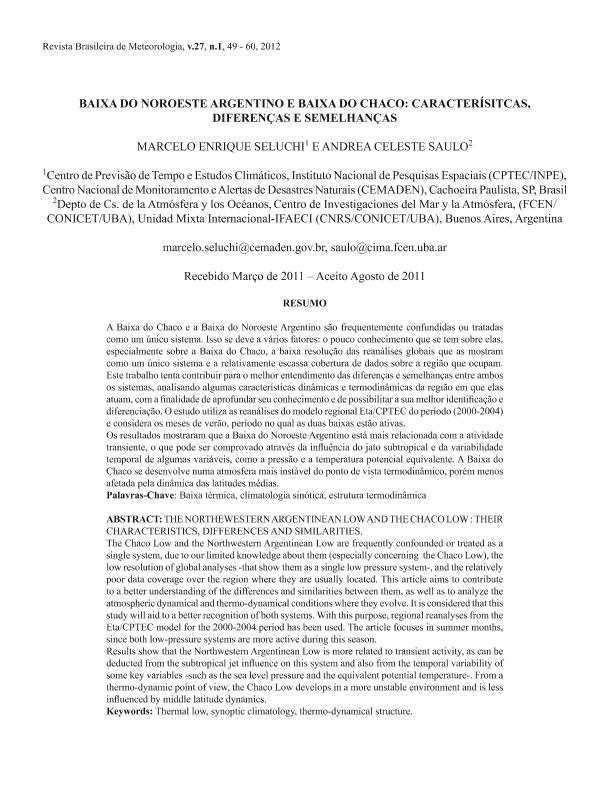Mostrar el registro sencillo del ítem
dc.contributor.author
Seluchi, Marcelo Enrique

dc.contributor.author
Saulo, Andrea Celeste

dc.date.available
2017-05-31T21:35:30Z
dc.date.issued
2012
dc.identifier.citation
Seluchi, Marcelo Enrique; Saulo, Andrea Celeste; Baixa do Noroeste Argentino e baixa do Chaco: caracterísitcas, diferenças e semelhanças; Sociedade Brasileira de Meteorologia; Revista Brasileira de Meteorologia; 27; 1; -1-2012; 49-60
dc.identifier.issn
0102-7786
dc.identifier.uri
http://hdl.handle.net/11336/17228
dc.description.abstract
A Baixa do Chaco e a Baixa do Noroeste Argentino são frequentemente confundidas ou tratadas como um único sistema. Isso se deve a vários fatores: o pouco conhecimento que se tem sobre elas, especialmente sobre a Baixa do Chaco, a baixa resolução das reanálises globais que as mostram como um único sistema e a relativamente escassa cobertura de dados sobre a região que ocupam. Este trabalho tenta contribuir para o melhor entendimento das diferenças e semelhanças entre ambos os sistemas, analisando algumas características dinâmicas e termodinâmicas da região em que elas atuam, com a finalidade de aprofundar seu conhecimento e de possibilitar a sua melhor identificação e diferenciação. O estudo utiliza as reanálises do modelo regional Eta/CPTEC do período (2000-2004) e considera os meses de verão, período no qual as duas baixas estão ativas. Os resultados mostraram que a Baixa do Noroeste Argentino está mais relacionada com a atividade transiente, o que pode ser comprovado através da influência do jato subtropical e da variabilidade temporal de algumas variáveis, como a pressão e a temperatura potencial equivalente. A Baixa do Chaco se desenvolve numa atmosfera mais instável do ponto de vista termodinâmico, porém menos afetada pela dinâmica das latitudes médias.
dc.description.abstract
The Chaco Low and the Northwestern Argentinean Low are frequently confounded or treated as a single system, due to our limited knowledge about them (especially concerning the Chaco Low), the low resolution of global analyses -that show them as a single low pressure system-, and the relatively poor data coverage over the region where they are usually located. This article aims to contribute to a better understanding of the differences and similarities between them, as well as to analyze the atmospheric dynamical and thermo-dynamical conditions where they evolve. It is considered that this study will aid to a better recognition of both systems. With this purpose, regional reanalyses from the Eta/CPTEC model for the 2000-2004 period has been used. The article focuses in summer months, since both low-pressure systems are more active during this season. Results show that the Northwestern Argentinean Low is more related to transient activity, as can be deducted from the subtropical jet influence on this system and also from the temporal variability of some key variables -such as the sea level pressure and the equivalent potential temperature-. From a thermo-dynamic point of view, the Chaco Low develops in a more unstable environment and is less influenced by middle latitude dynamics.
dc.format
application/pdf
dc.language.iso
por
dc.publisher
Sociedade Brasileira de Meteorologia
dc.rights
info:eu-repo/semantics/openAccess
dc.rights.uri
https://creativecommons.org/licenses/by-nc-sa/2.5/ar/
dc.subject
Baixa Térmica
dc.subject
Climatologia Sinótica
dc.subject
Estrutura Termodinâmica
dc.subject.classification
Meteorología y Ciencias Atmosféricas

dc.subject.classification
Ciencias de la Tierra y relacionadas con el Medio Ambiente

dc.subject.classification
CIENCIAS NATURALES Y EXACTAS

dc.title
Baixa do Noroeste Argentino e baixa do Chaco: caracterísitcas, diferenças e semelhanças
dc.title
The Northewestern Argentinean low and the Chaco low: their characteristics, differences and similarities
dc.type
info:eu-repo/semantics/article
dc.type
info:ar-repo/semantics/artículo
dc.type
info:eu-repo/semantics/publishedVersion
dc.date.updated
2017-05-31T19:43:14Z
dc.identifier.eissn
1982-4351
dc.journal.volume
27
dc.journal.number
1
dc.journal.pagination
49-60
dc.journal.pais
Brasil

dc.journal.ciudad
São José dos Campos
dc.description.fil
Fil: Seluchi, Marcelo Enrique. Centro de Previsao de Tempo e Estudos Climaticos; Brasil. Consejo Nacional de Investigaciones Científicas y Técnicas; Argentina
dc.description.fil
Fil: Saulo, Andrea Celeste. Consejo Nacional de Investigaciones Científicas y Técnicas. Oficina de Coordinación Administrativa Ciudad Universitaria. Centro de Investigaciones del Mar y la Atmosfera. Universidad de Buenos Aires. Facultad de Ciencias Exactas y Naturales. Centro de Investigaciones del Mar y la Atmosfera; Argentina
dc.journal.title
Revista Brasileira de Meteorologia

dc.relation.alternativeid
info:eu-repo/semantics/altIdentifier/doi/http://dx.doi.org/10.1590/S0102-77862012000100006
dc.relation.alternativeid
info:eu-repo/semantics/altIdentifier/url/http://ref.scielo.org/gwbcbd
dc.relation.alternativeid
info:eu-repo/semantics/altIdentifier/url/http://www.rbmet.org.br/port/revista/revista_artigo.php?id_artigo=1086
Archivos asociados
